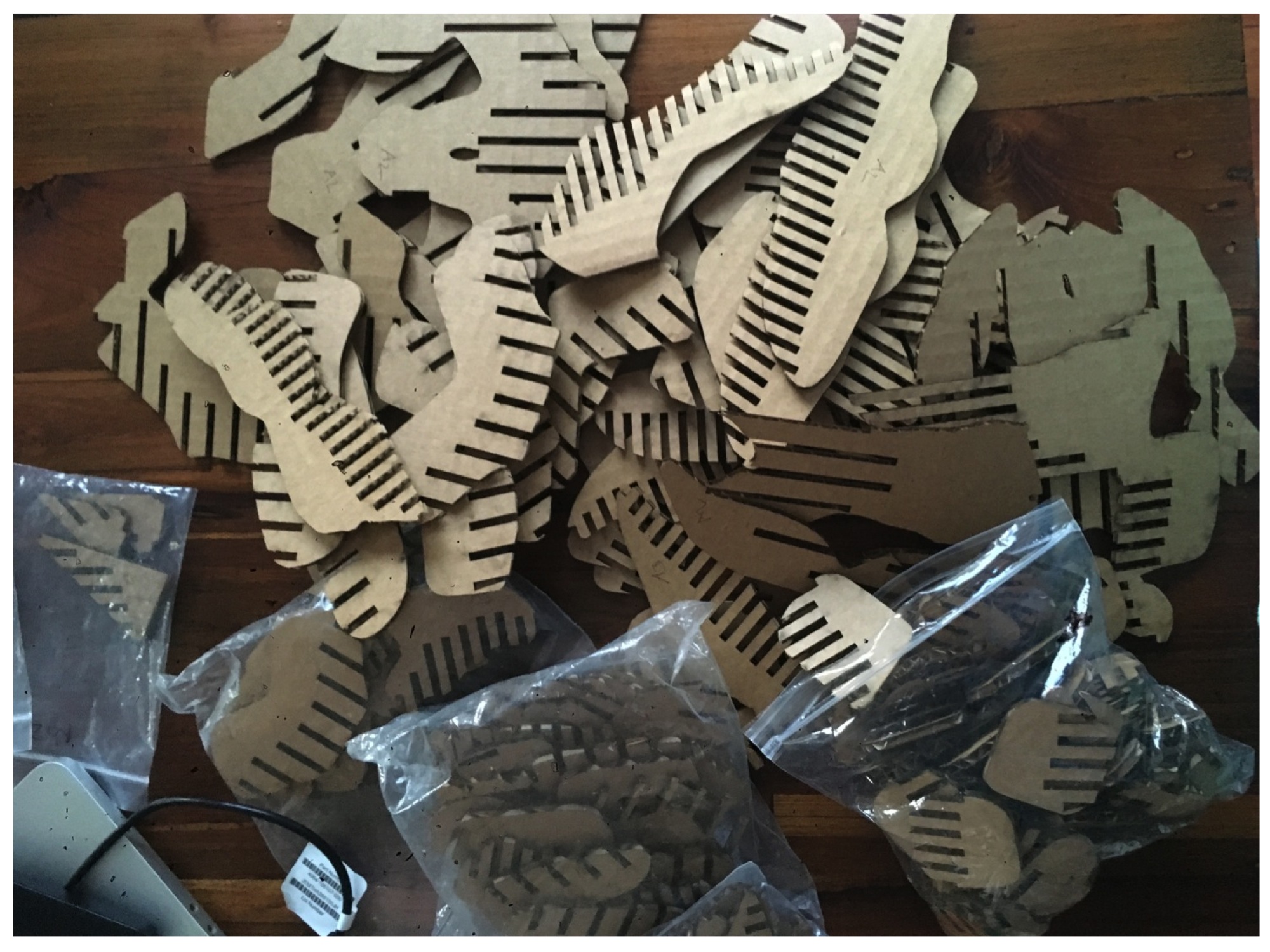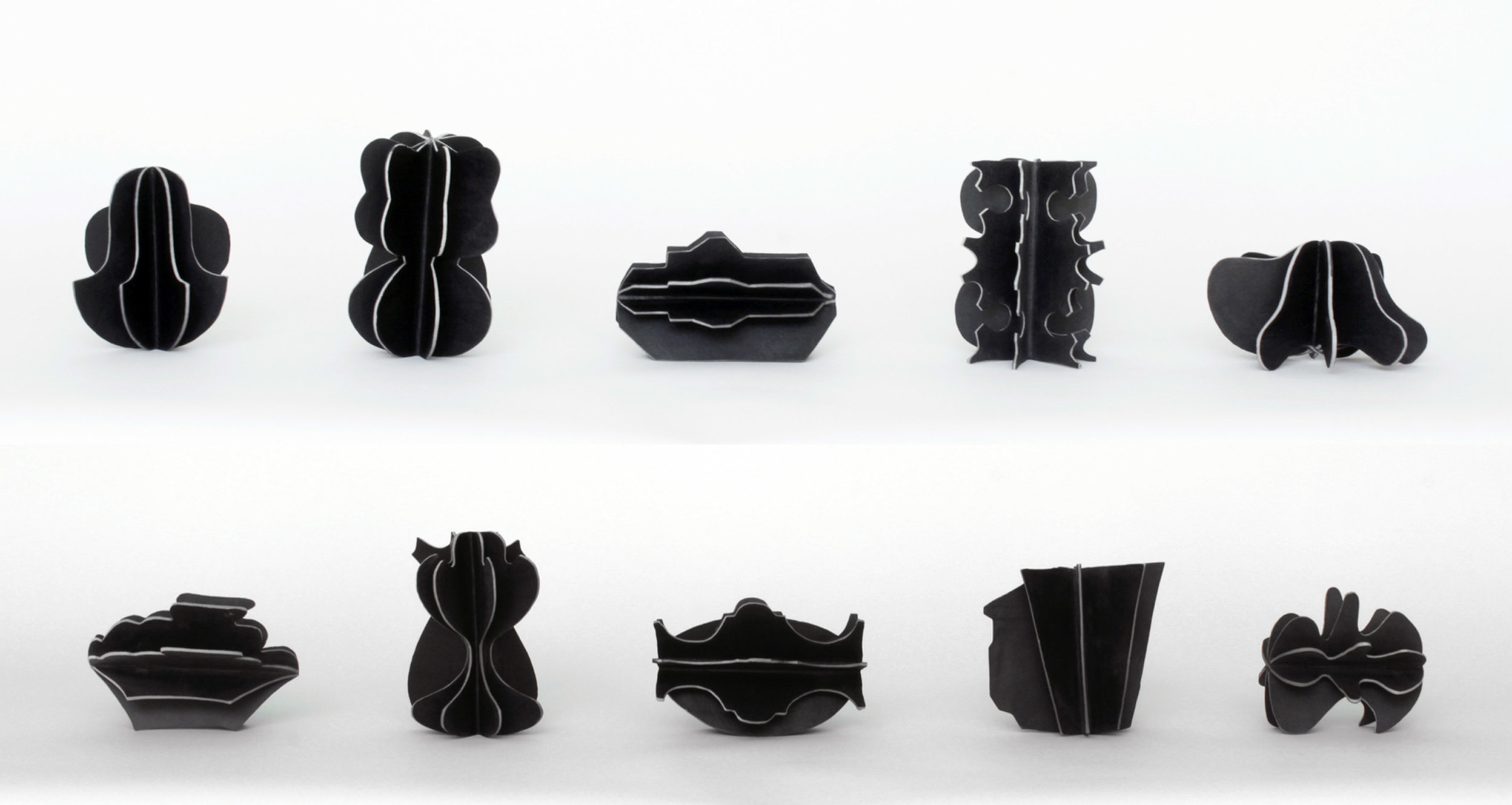In the Spring of 2014, while in residence at the Bullseye Bay Area Research Center I stumbled into what would occupy my investigative interest for the next years to come.
Working on a large wall piece titled “Rorschach” I was mixing up batches of black glass enamel to create the inkblot patterns of the piece. In spilling a jar of the enamel paint I wiped it up with a paper towel and remembered the organic burn out technique used in ceramics where organic material are dipped into slip casting clay. The clay soaked materials turn in the firing into solid clay objects as the original material burns away. I put the enamel soaked paper towel in the kiln and fired it. Which turned into the first moldless pate de verre object I created. With little intension, other than a curiosity of what would happen I had no idea what the moment of spilling enamel would start off.
working on Rorschach
The fired paper towel
Now over three years later, I have arrived at a stage where things have become quite a bit more complex. In the past years I have developed a variety of types of glass pastes that have specialized characteristics to fulfill specific requirements. I created a glass paste with a consistency of whipped cream that can easily be spread onto a surface and has the ability to stay in place and not run off.
The white appearing forms is the clear paste applied to cardboard forms, before they are coated with a layer of color and fired
The finished and fired forms
Out of this spreadable paste, I was also able to make sheets of paste, which cut into shapes I am able to assemble into objects. As I started working on pieces created out of components a gluing paste was an important product to develop, with a worklife long enough to complete the joining process, that would dry into a hard, non-flexible material to reduce stress on the joints of the pieces while being handled before firing.
I have also developed a paste that behaves like clay. It is just as moldable as clay and can be rolled out into sheets, cut with cookie cutters, pushed through an extruder and hand molded into the desired object.
The moldable paste
The same past's extruded using a custom milled die.
I had worked through trial and error for two years in my studio, pushing my way through a number of challenges that had to be solved. How to support the pieces during the firing, What binders will burn out stain free, how to construct the supporting structures onto which the pastes are applied, how to solve drying shrink and firing shrink…
Two years earlier, when I applied for the Technology Advancing Glass Art Grant in the summer of 2014 I had only started working on this method and had not much more than a vague idea of what might be possible. Seeing the potential but also the amount of resources it would take to become serious about developing this process I submitted my application to the TAG Grant. Without the commitment I had entered into through receiving the TAG Grant I would have abandoned the project at some point. It has been a very difficult process.
In the summer of 2016 I started the Specialty Glass Residency at the Corning Inc. research Facility in Sullivan Park. Together with Dr. Patrick Teppesch we refined pastes and created new ones. This half year in 2016 was the most exciting time, because I wasn’t alone in a less than ideal studio situation, without tools and materials, but connected to a facility where any chemical is available, measuring techniques and charting was a given part of the process. It was an environment set up to do just what I needed.
A lot of my time was taken up by creating pastes. What I had applied to the TAG Grant with was the need of rapid prototyping for this project.
Removing the plaster silica mold from creating pate de verre, I had to come up with other materials onto which the glass paste could be applied. The first paste I developed was the spreadable paste. Cardboard was an easily moldable material out of which almost anything can be constructed. In the beginning I would cut the cardboard models by hand, spending days to cut, crease and fold up three-dimensional geometric forms onto which I could brush the glass paste.
Manual cardboard construction and creation process
The finished piece, The Boat-2014
This being highly inefficient and time consuming I started creating the cardboard forms in the 3d modeling program Rhino and laser cutting the cardboard. Rhino can turn any three dimensional structure into a flat layout, which can be imported into the laser cutter operating program. In either program you can also assign details of your layout to be on the cut layer and the etch layer. The etch layer will create a partial cut into the material, which can be used as crease lines. Moving the creative process of the cardboard into the digital realm simplified the labor of the making process.
Laser cut cardboard forms ready for assembly
3d scan of Kieran, with reduced polygon mesh parts for cutting and assembly
used and removed cardboard forms, ready to be reused
cut and partially assembled head
The incredible advantage of 3d modeling is that relative speed in which anything can be created. No actual materials and resources are being used to figure out a form and changing your mind about what you make doesn’t mean that you have to throw away lots of materials but you just change your model. Making decisions before they become physical reality is an incredibly helpful feature. Unfortunately the learning curve for these programs and machines is long and slow and the speed at which they programs get upgraded makes it hard to follow along. Also the availability to the general public of such technologies is still lacking. I was fortunate enough to be able to use the maker space of the Human Centered Design and Engineering Program at the University of Washington, both as a Graduate student and as an alumni.
With the development of the clay-like paste I needed to make my own tools to be able to extrude the paste into shapes. I created dies for a simple extruder through which the pastes are pushed. I have been using an OtherMill, which is a small desktop milling machine. The drawback of this machine is the speed at which it can cut. Milling my own tools required me to learn an additional number of programs.
The OtherMill and program showing the progress on the milling time
Some dies
The die modeled in Rhino.
A die and extruded paste
In the Maker Space at the University of Washington I was also introduced to Virtual Reality modeling. It is the newest bit of technology and still in progress of becoming a great tool. Virtual Reality modeling or VR modeling can be learned in an extremely short period of time and the modeling happens in a three-dimensional space, in which you as the maker are part of.
Wearing a large headset, with glasses and headphones, your hands holding remote controls that feature buttons you become part of the computer generated space. Two cameras track your motion and through your headset you see a virtual rendering of your hands. The controls let you draw and paint in the virtual space and through your headset you can see everything appear in front of you. Being able to sculpt in the same space instead inside a flat screen in front of you helps you create complex objects that are proportioned in relation the real space.
Some of the objects I modeled in VR
I had often found it hard to model on the computer inside a grid, without any physical reference, which is usually the case when sculpting in the real world. Anything you model in VR can be plugged into other existing programs, turned into templates for laser cutting or 3d printing. In the future I hope this program will continue to become more refined with more features as it opens up new way of sculpting forms quickly, without the restraint of gravity and materiality before producing them in the real world.
The 3d model imported into Slicer to prepare for laser cutting
Laser cut parts
The two parts of the TAG Grant project, the development of the pastes and the application of rapid prototyping needed to happen in tandem to be able to create new forms. In the future I hope to refine this technique. There are still a lot of problems to be solved and questions to be answered before it is an easily applicable process.
At this point the past’s I have created can be thrown on the potters wheel, just like clay. It can be hand molded like clay, slipcase like clay into cardboard or foam forms. It can be brushed onto forms or cast into sheets, which can be cut with scissors or flexible molded and bend by hand before firing.
Some paste in action below:










































